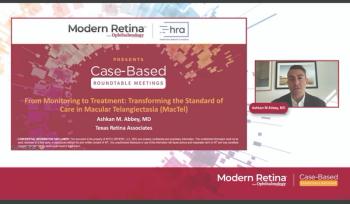
- Modern Retina Winter 2024
- Volume 4
- Issue 4
Ocular nerve regrowth following use of diabetes drug
A case report demonstrates independent effect of GLP-1 receptor agonist.
Reviewed by Hoda Gad, PhD, MSc, BSc
Monogenic obesity is a rare and severe disease most often resulting from melanocortin-4 receptor (MC4R) mutations that disrupt the neuronal pathways in the hypothalamus and prefrontal cortex. Following 6 months of treatment with semaglutide, a glucagon-like peptide-1 (GLP-1) receptor agonist, the investigators observed that 2 siblings with monogenic obesity had nerve regeneration and positive changes in the corneal nerves.1
First author Hota Gad, MSc, BSc, from the Research Department, Weill Cornell Medicine-Qatar, Doha, Qatar, reported their findings in Frontiers in Endocrinology. Patients with monogenic obesity present with impaired satiety and hyperphagia in early childhood with severe early-onset obesity due to dysregulation of the central leptin-melanocortin neuronal pathways.2,3 They explained that changes in lifestyle in patients with MC4R mutations have shown minimal benefit4-6 and even bariatric surgery provided limited long-term benefit.7-9
However, use of GLP-1 receptor agonists can achieve beneficial changes in weight, blood pressure, lipids with a decrease in reactive oxygen species, and inflammation, which could impact neurons,10 they explained.
Specifically, they reported that GLP-1 receptor–mediated extracellular signal-regulated kinase signaling in diabetic rodents protected large motor fiber function and small fiber structure by a mechanism independent of glycemic control.11 They also reported corneal nerve regeneration after bariatric surgery12 and with once-weekly dosing with the GLP-1 agonist exenatide,13 and in 14 patients with type 2 diabetes, semaglutide or dulaglutide improved nerve area and sural nerve amplitude.14
In this case report, Gad and colleagues performed corneal confocal microscopy to assess for evidence of nerve regeneration after treatment with semaglutide in siblings with an MC4R gene mutation, a 10-year-old boy (weight, 100.3 kg; body mass index [BMI], 39.7 kg/m2) and his 8-year-old sister (weight, 58.6 kg; BMI, 32.2 kg/m2).
Their respective baseline hemoglobin A1C (HbA1C) values were 5.8% and 5.6%; the total cholesterol, 4.4 and 3.4 mmol/L; low-density lipoprotein, 2.3 and 2 mmol/L; high-density lipoprotein, 2.1 and 1 mmol/L; and triglycerides, 1 and 1.4 mmol/L. Both exhibited intense hyperphagia, impaired satiety, and severe, early-onset obesity.
The siblings had a heterozygous missense variant c.508A>G, p.Ille170Val in the MC4R gene, a rare variant with minor allele frequency in gnomAD of 0.00009. They both were treated with semaglutide 0.5 mg weekly for
1 month and then 1.0 mg weekly for 5 months.
Results of semaglutide therapy
Corneal confocal microscopy showed corneal small fiber degeneration in the 2 siblings.
The investigators reported, “We also showed that 6 months of treatment with semaglutide was associated with small nerve fiber regeneration, but with no major effect on weight, HbA1C, and lipids, which argues for alternate mechanisms beyond an improvement in weight and glycemia as a basis for nerve regeneration in these 2 children with MC4R gene mutation.”
The observed nerve regeneration included the following increases in the brother and the sister, respectively: corneal nerve fiber density, 13.9% and 14.7%; corneal nerve branch density, 110.2% and 58.7%; and corneal nerve fiber length, 21.5% and 44.0%.
Hypothesis for nerve regeneration without other changes
The investigators explained that obesity is a risk factor for small fiber neuropathy,15,16 and they had reported previously that nerve regeneration occurred and the weight and metabolic parameters improved after bariatric surgery.17,18 In addition, GLP-1 receptor agonists reduce weight and improve many neuropathic risk factors including hyperglycemia, blood pressure, and hyperlipidemia.19 Previous case reports on use of the daily GLP-1 agonist liraglutide have shown reduced weight and improved glycemia.20-22 However, their recent cohort study showed no major impact of liraglutide on weight or HbA1C in obese children.23
It is noteworthy, Gad and colleagues explained, that GLP-1 therapies activate sirtuin 1,24,25 which may be associated with the nerve regeneration seen in the patients under discussion, independent of weight and glycemia changes. In addition, GLP-1 receptors are expressed in the dorsal root ganglion and peripheral nerves,26-29 and in an animal model of type 1 diabetes, GLP-1 treatment led to intraepidermal nerve fiber regeneration without weight or glucose changes.11 Further, adults with type 2 diabetes treated with once-weekly exenatide and pioglitazone had small nerve fiber regeneration, despite an increase in weight.13
They concluded, “We believe that our study provides novel insights into the complications associated with MC4R gene mutation as evidenced by subclinical neurodegeneration. Furthermore, we show nerve regeneration after treatment with semaglutide, without an improvement in weight or glycemia, indicating an independent effect of GLP-1 therapy, which merits further study.” •
References
1. Gad H, Mohammed I, Dauleh H, et al. Case report: nerve fiber regeneration in children with melanocortin 4 receptor gene mutation related obesity treated with semaglutide. Front Endocrinol. 2024;15:1385463. doi:10.3389/fendo.2024.1385463
2. Mohammed I, Haris B, Al-Barazenji T, et al. Understanding the genetics of early-onset obesity in a cohort of children from Qatar. J Clin Endocrinol Metab. 2023;108(12):3201-3213. doi:10.1210/clinem/dgad366
3. Huvenne H, Dubern B, Clément K, Poitou C. Rare genetic forms of obesity: clinical approach and current treatments in 2016. Obes Facts. 2016;9(3):158-173. doi:10.1159/000445061
4. Reinehr T, Hebebrand J, Friedel S, et al. Lifestyle intervention in obese children with variations in the melanocortin 4 receptor gene. Obesity (Silver Spring).2009;17(2):382-389. doi:10.1038/oby.2008.422
5. Hainerova I, Larsen LH, Holst B, et al. Melanocortin 4 receptor mutations in obese Czech children: studies of prevalence, phenotype development, weight reduction response, and functional analysis. J Clin Endocrinol Metab. 2007;92(9):3689-3696. doi:10.1210/jc.2007-0352
6. Trier C, Hollensted M, Schnurr TM, et al. Obesity treatment effect in Danish children and adolescents carrying melanocortin-4 receptor mutations. Int J Obes (Lond).2021;45(1):66-76. doi:10.1038/s41366-020-00673-6
7. Vos N, Oussaada SM, Cooiman MI, et al. Bariatric surgery for monogenic non-syndromic and syndromic obesity disorders. Curr Diabetes Rep. 2020;20(9):44. doi:10.1007/s11892-020-01327-7
8. Poitou C, Puder L, Dubern B, et al. Long-term outcomes of bariatric surgery in patients with bi-allelic mutations in the POMC, LEPR, and MC4R genes. Surg Obes Relat Dis. 2021;17(8):1449-1456. doi:10.1016/j.soard.2021.04.020
9. Cooiman MI, Alsters SIM, Duquesnoy M, et al. Long-term weight outcome after bariatric surgery in patients with melanocortin-4 receptor gene variants: a case-control study of 105 patients. Obes Surg. 2022;32(3):837-844. doi:10.1007/s11695-021-05869-x
10. Goldney J, Sargeant JA, Davies MJ. Incretins and microvascular complications of diabetes: neuropathy, nephropathy, retinopathy and microangiopathy. Diabetologia. 2023;66(10):1832-1845. doi:10.1007/s00125-023-05988-3
11. Jolivalt CG, Fineman M, Deacon CF, Carr RD, Calcutt NA. GLP-1 signals via ERK in peripheral nerve and prevents nerve dysfunction in diabetic mice. Diabetes Obes Metab. 2011;13(11):990-1000. doi:10.1111/j.1463-1326.2011.01431.x
12. Adam S, Azmi S, Ho JH, et al. Improvements in diabetic neuropathy and nephropathy after bariatric surgery: a prospective cohort study. Obes Surg.2021;31(2):554-563. doi:10.1007/s11695-020-05052-8
13. Ponirakis G, Abdul-Ghani MA, Jayyousi A, et al. Effect of treatment with exenatide and pioglitazone or basal-bolus insulin on diabetic neuropathy: a substudy of the Qatar Study. BMJ Open Diabetes Res Care. 2020;8(1):e001420. doi:10.1136/bmjdrc-2020-001420
14. Dhanapalaratnam R, Issar T, Lee ATK, et al. Glucagon-like peptide-1 receptor agonists reverse nerve morphological abnormalities in diabetic peripheral neuropathy. Diabetologia. 2024;67(3):561-566. doi:10.1007/s00125-023-06072-6
15. Herman RM, Brower JB, Stoddard DG, et al. Prevalence of somatic small fiber neuropathy in obesity. Int J Obes (Lond).2007;31(2):226-235. doi:10.1038/sj.ijo.0803418
16. Johnson SA, Shouman K, Shelly S, et al. Small fiber neuropathy incidence, prevalence, longitudinal impairments, and disability. Neurology. 2021;97(22):e2236-e2247. doi:10.1212/WNL.0000000000012894
17. Azmi S, Ferdousi M, Liu Y, et al. Bariatric surgery leads to an improvement in small nerve fibre damage in subjects with obesity. Int J Obes (Lond). 2021;45(3):631-638. doi:10.1038/s41366-020-00727-9
18. Iqbal Z, Kalteniece A, Ferdousi M, et al. Corneal keratocyte density and corneal nerves are reduced in patients with severe obesity and improve after bariatric surgery. Invest Ophthalmol Vis Sci.2021;62(1):20. doi:10.1167/ iovs.62.1.20
19. Wilding JPH, Batterham RL, Calanna S, et al. Once-weekly semaglutide in adults with overweight or obesity. N Engl J Med. 2021;384(11):989-1002. doi:10.1056/NEJMoa2032183
20. Iepsen EW, Zhang J, Thomsen HS, et al. Patients with obesity caused by melanocortin-4 receptor mutations can be treated with a glucagon-like peptide-1 receptor agonist. Cell Metab.2018;28(1):23-32.e3. doi:10.1016/j.cmet.2018.05.008
21. Iepsen EW, Have CT, Veedfald S, et al. GLP-1 receptor agonist treatment in morbid obesity and type 2 diabetes due to pathogenic homozygous melanocortin-4 receptor mutation: a case report. Cell Rep Med. 2020;1(1):100006. doi:10.1016/j.xcrm.2020.100006
22. Welling MS, de Groot CJ, Kleinendorst L, et al. Effects of glucagon-like peptide-1 analogue treatment in genetic obesity: a case series. Clin Obes. 2021;11(6):e12481. doi:10.1111/cob.12481
23. Dauleh H, Pasha M, Gad H, et al. Single-center experience of using liraglutide in adolescents with obesity +/- type 2 diabetes. Cureus. 2024;16(4):e58720. doi:10.7759/cureus.58720
24. Bastien-Dionne PO, Valenti L, Kon N, Gu W, Buteau J. Glucagon-like peptide 1 inhibits the sirtuin deacetylase SirT1 to stimulate pancreatic β-cell mass expansion. Diabetes. 2011;60(12):3217-3222. doi:10.2337/db11-0101
25. Xiang J, Qin L, Zhong J, Xia N, Liang Y. GLP-1RA liraglutide and semaglutide improves obesity-induced muscle atrophy via SIRT1 pathway. Diabetes Metab Syndr Obes. 2023;16:2433-2446. doi:10.2147/DMSO.S425642
26. Merchenthaler I, Lane M, Shughrue P. Distribution of pre-pro-glucagon and glucagon-like peptide-1 receptor messenger RNAs in the rat central nervous system. J Comp Neurol. 1999;403(2):261-280. doi:10.1002/(ISSN)1096-9861
27. Ban K, Noyan-Ashraf MH, Hoefer J, Bolz SS, Drucker DJ, Husain M. Cardioprotective and vasodilatory actions of glucagon-like peptide 1 receptor are mediated through both glucagon-like peptide 1 receptor-dependent and -independent pathways. Circulation. 2008;117(18):2340-2350. doi:10.1161/CIRCULATIONAHA.107.739938
28. Vrang N, Larsen PJ. Preproglucagon derived peptides GLP-1, GLP-2 and oxyntomodulin in the CNS: role of peripherally secreted and centrally produced peptides. Prog Neurobiol. 2010;92(3):442-462. doi:10.1016/j.pneurobio.2010.07.003
29. Pyke C, Heller RS, Kirk RK, et al. GLP-1 receptor localization in monkey and human tissue: novel distribution revealed with extensively validated monoclonal antibody. Endocrinology. 2014;155(4):1280-1290. doi:10.1210/en.2013-1934
Articles in this issue
about 1 year ago
Excellence across the board at the 2024 Euretina Congressabout 1 year ago
A-memia? Anecdotal evidence in the era of memesabout 1 year ago
The deep dish on all things ophthalmology at AAO 2024about 1 year ago
Advancements in ocular drug deliveryabout 1 year ago
A field guide to optic disc drusenNewsletter
Keep your retina practice on the forefront—subscribe for expert analysis and emerging trends in retinal disease management.












































